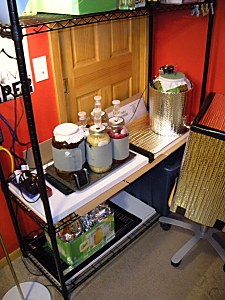Gut Health Simple Sauerkraut – Airlock Method
by: John Herron
The airlock method is the most trouble-free method of making delicious fermented foods, like sauerkraut. Much reduced smells, no slime to scrape off, no special crocks to purchase, and delicious results every time. Lacto-fermented sauerkraut (the traditional method) is crisp and tart, almost everyone likes it better than store bought; even people that normally hate sauerkraut loves it.
Remember that if you cook lacto-fermented sauerkraut you will lose the probiotic benefits (the bacteria will die). If you have SIBO or another gut dysbiosis you really need to increase you ferments. If you have histamine intolerance or MCAD see #3 below.
Supplies / Ingredients
- 2 Quart Mason Jar with ring. Should be washed on “Sanitize” or washed normally and rinsed with white vinegar.
- Airlock lid (See note #1 below and instructions to make your own that follow)
- Airlock (I prefer the “S” shaped “double bubble” type like this http://amzn.to/1jqRh75), less chance of tap water getting in to the bottle than with bell types.
- Dowel, tapper, or large wooden spoon
- Glass votive candle holder (should be completely clean and rinsed in white vinegar), this is called the “overflow cup” below. (Amazon) (not needed if you purchased a kit)
- Spring water, filtered water, or boiled water (should be free of chlorine, flouride free also helps)
- 3-4 lbs of fresh cabbage (organic is best as its likely to have the most diverse bacteria strains). Should work out to about 3lbs cored and with outer leaves removed.
- 1 1/2 Tbls of real Sea Salt (“Real Salt” or fine Himalayan Salt)
- Optional: Mandolin (for slicing cabbage) (Amazon)
- Optional: 1 Tbsp caraway seeds
Instructions
- Thinly shred cabbage into long shreds (about the width of a spaghetti noodle, about 2mm). This can be done with sharp long knife, but a mandolin makes it much faster.
- Work salt into cabbage. (do not cut or overly increase the salt, too little allows pathogens to grow, too much and your cabbage won’t ferment correctly)
- Optional: Work caraway seeds into cabbage
- Working in a large bowl or stock pot, squeeze and press the shredded cabbage to release the juices, be sure keep the liquid.
- Put a plate over the cabbage and weigh down with a couple bricks, gallon jug of water or something else of about that weight. Leave for 30 minutes to 4 hours.
- Add cabbage / brine mixture to jar, tapping down as you go. This is to prevent air pockets from forming. Be sure to include all the brine you can, if you have some left poke a butter knife through the cabbage in a few spots to try to get more brine to flow through. Leave about 1.5” of room from the top.
- If there is not enough brine to completely cover the cabbage you will need to add a brine mixture. You can make this with 1/2 Tbsp of sea salt to 1 cup of filtered water, mix well. Use this to cover the cabbage. (Note #2)
- Put the overflow cup on top of the cabbage (opening facing up). This will be used to catch excess fluid that will bubble up. The top of the candle holder should be just below the top of the jar (about 1/8th to 1/4“ down from the jar lip)
- Put the airlock lid with gasket on the jar, firmly screw on the jar ring.
- Push the airlock into the grommet, it only needs to go in about 1/2“.
- Fill airlock with tap water per instructions or up to the fill line (if you have neither fill about halfway, or if a double bubble style, halfway on both sides)
- Because overflows can happen, put the jar in a pie dish or similar.
- Check once every day or two to make sure no brine has pushed into the airlock or from under the gasket. If it has, remove the lid empty the overflow cup, remove just enough brine to be able to be able to put the overflow cup back in the brine and close it up without the brine overflowing the bottle or into the overflow cup.
- When checking the kraut make sure it isn’t going dry, the cabbage should always be below brine. If the brine level starts to get near the top of the cabbage you’ll need to remove the lid to add more. The brine ratio is the same as above, 1/2 Tbsp of sea salt to 1 cup of filtered water, mixed well.
- During fermentation you will sometimes see bubbles in the jar and airlock. This is normal and desired. In a double bubble airlock all the water may move to the distant bubble (the one away from the jar), this is caused by CO2 pressure in the bottle. You may also see all the water move to the jar side sometimes, this is caused by temperature differences between what’s in the bottle and the room temperature. This is all normal. If you never see any of this happen, that is not normal, and means your kraut may not be fermenting.
- Ferment from 2 weeks to 6 months, depending on how you like your sauerkraut. I recommend starting with 2 weeks if you’ve never made sauerkraut before. Cooler temps, 55-65°F work best, but warmer temps will also work, just make sure to check it more often.
- Refrigerate with a standard lid or take what you want to eat and let it ferment some more (with the airlock) in the coolest part of your home.
Notes
#1 My favorite commercial airlock jars / lids are the Probiotic Jar kits. These are better than my homemade lids in that everything that comes in to contact with the acidic ferment is glass and food safe rubber. The only problem with mine below is that the rings will start to rust a little over time. The rings don’t contact the food, but the liquid will bubble or off gas through the screw on rings and, overtime, cause them to rust. Of course making your own is also less expensive. In addition to using the Probiotic Jar system, I continue to use my homemade lids as well, I just replace the rings every few months.
#2 This page has excellent information for making brines used in various recipes.
#3 For someone with Histamine Intolerance consuming fermented foods is usually off-limits; fermented foods simply contain too much histamine, normally. However, there is research that shows that anaerobically fermenting foods (e.g. in an airlock jar) for 2-3 months removes the histamines. This is because the bacteria that produce the histamines is done after 10-14 days, and the new bacteria (still probiotic) that take over the process actually consume and denature the histamine that was left behind.
| These statements have not been evaluated by the Food and Drug Administration. This product is not intended to diagnose, treat, cure, or prevent any disease. |
All images posted by John Herron are either "Copyrighted John Herron", or are copyrighted by someone else and are used under license. So please don’t use them elsewhere, you’ll get in trouble.


 Phage Complete comes with a full 30 day money back guarantee, for U.S. purchases this includes the original shipping charges to you!
Phage Complete comes with a full 30 day money back guarantee, for U.S. purchases this includes the original shipping charges to you!
Fermenting “in the coolest part of your home” isn’t very specific. Is it ok if the fermentation temp is in the mid-70’s? (I live in Florida.) If not, how successful is fermentation in the refrigerator?